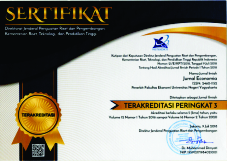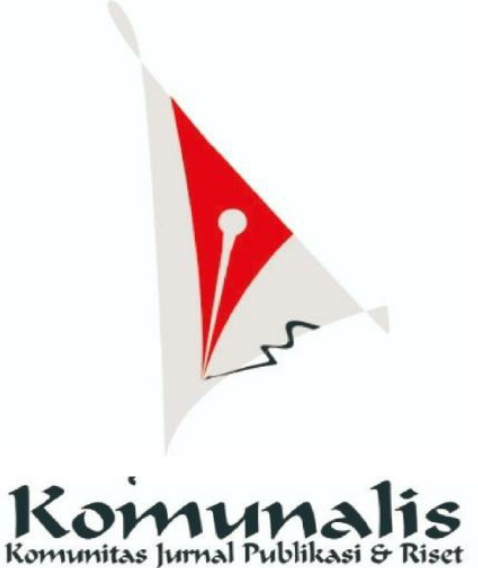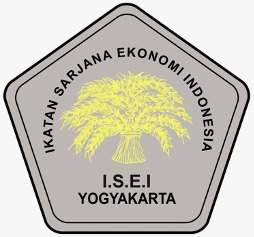The Effect of Financial Literacy and Financial Inclusion on Small Enterprises Performance in East Kalimantan
Downloads
The aim of this paper is to find out the effect of financial literacy on enterprises (SEs) performance and the effect of financial inclusion on small enterprises (SEs) performance. This research is an explanatory research. The sample includes 100 SEs in East Kalimantan. The sample is gathered by using non probability sampling technique. By implementing census approach the data is gathered from all SEs in East Kalimantan. This study was a quantitative approach and data were analyzed using PLS (Partial Least Square). The unit of level analysis is the SEs business players in East Kalimantan. The results showed a positive and significant effect of financial literacy on enterprises (SEs) performance and, financial inclusion positively affects the performance of small enterprises (SEs).
Keywords: financial literacy, financial inclusion, small enterprises performance
Pengaruh Literasi Keuangan dan Inklusi Keuangan Terhadap Kinerja Usaha Kecil di Kalimantan TimurAbstrak
Penelitian ini bertujuan untuk mengetahui pengaruh literasi keuangan terhadap kinerja usaha kecil, dan pengaruh inklusi keuangan terhadap kinerja usaha kecil. Jenis penelitian ini adalah penelitian explanatory. Sampel penelitian adalah 100 UMKM yang ada di Kalimantan Timur. Sampel dikumpulkan menggunakan teknik non probability sampling dengan pendekatan sensus yaitu mengambi seluruh UMKM yang beroperasi di Kalimantan Timur untuk dijadikan sampel dan dilakukan pengujian untuk menjawab isu penelitian yang diangkat. Penelitian ini bersifat kuantitatif dan menggunakan alat analisis PLS (Partial Least Square). Level unit analisis penelitian ini adalah pelaku usaha kecil di Kalimantan Timur. Hasil penelitian menunjukkan bahwa literasi keuangan berpengaruh secara signifikan terhadap kinerja usaha kecil dan inklusi keuangan memiliki pengaruh signifikan terhadap kinerja usaha kecil.
Kata kunci: literasi keuangan, inklusi keuangan, kinerja usaha kecil
Downloads
Agarwal, T. (2016). An Analysis of the Twin Pillars of the Banking in India: Financial Literacy and Financial Inclusion. Gavesana Journal of Management, 8 (1-2), 1-12.
Atkison, A. & Messy, F.A. (2014). Assessing Financial Literacy in 12 Countries : an OECD Pilot Exercise. Netspa
Bank Indonesia. (2011). Five Finger Philosophy:Upaya Memberdayakan UMKM. Diakses dari http://www.bi.go.id/web/id/ UMKMBI/ Koordinasi/ Filosofi+ Lima + Jari/ pada tanggal 3 Oktober 2018.
Bank Indonesia. (2014). Departemen Pengembangan Akses Keuangan dan UMKM: Buku Saku Keuangan Inklusif, [pdf]. Diakses dari https://www.bi.go.id/id/perbankan/ keuanganinklusif/ pada tanggal 23 November 2018.
Bank Indonesia. (2016). Keuangan Inklusif. Diakses dari https://www.bi.go.id/id/ perbankan/ keuanganinklusif/ Indonesia pada tanggal 16 April 2018.
Bank Indonesia. (2017). Departemen Kebijakan Makroprudensial : Kajian Stabilitas Keuangan No. 28 Maret 2017 : Mitigasi Risiko Sistemik Melalui Penguatan Koordinasi Antar Institusi di Tengah Konsolidasi Perekonomian Domestik. Diakses dari http://www.bi.go.id/id/publikasi/perbankandanstabilitas/ kajian/Documents/ KSK-Edisi-28-2017.pdf pada tanggal 16 Desember 2018.
Beck, T., & Demirguc Kunt, A. (2006). Small and medium-size enterprises: Access to Finance as a Growth Constraint. Journal of Banking & Finance, (30,)11,2931-2943.
Bongomin. G.O.C. (2017). Financial Literacy in Emerging Economies : Do All Components Matter for Financial Inclusion of Poor Households in Rural Uganda?. Managerial Finance Journal, 43, (12), 1310-1331.
Bongomin. G.O.C. (2017). The Relationship Between Access to Finance and Growth if SMEs in Developing economies: Financial Literacy As A Moderator. International Business and Strategy Journal, 27 (4),520-538.
Bongomin. G.O.C., Ntayi, J. M., Munene, J.C., & Nabeta, I.M. (2016). Social Capital: Mediator of Financial Literacy and Financial Incluaion In rural Uganda. International Business and Strategy Journal, 26, (2), 291-312.
Cihak, M., Demirguc, K.A., Erik, F. & Levine, R. (2012). Benchmarking Financial Systems Around The World. The World Bank Policy Research Working Paper, 6175. Washington,DC : The World Bank.
Davidsson, P., Leona, A.L. & Naldi, L. (2010). Small Firm Growth. Foundations and Trends in Entrepreneurship, 6 (2), 69-166.
Ghozali, I. (2014). Structural Equation Modeling : Metode Alternatif dengan Partial Least Square (PLS). (Edisi 4). Semarang : Badan Penerbit Universitas Diponegoro.
Global Entrepreneurship Monitor. (2016). Global Entrepreneurship Monitor 2016 Indonesian Report. Diakses dari http://www.gemconsortium.org/ pada tanggal 23 November 2018.
Greenspan, A. (2002). Financial literacy : A Tool for Economic Progress. The Futurist Journal, 36 (4), 37-41.
Lusardi, A. & Tufano, P. (2009). Debt Literacy, Financial Experiences, and over In Debtedness, Cambridge. Diakses dari http://dx.doi.org/10.3386/w14808 pada tanggal 16 April 2018.
Lusardi, A. (2009). US Household Savings Behavior: The Role of Financial Literacy : Information and Financial Education Programs. Policy making Insights from Behavioural Economics, 109-149.
Lusardi, A., & Mitchell, O. (2014). The Economic Importance of Financial Literacy: Theory and Evidence. Journal of Economic Literature, (33)1, 1-8.
Njoroge, C.W. & Gathungu, J.M. (2013). The Effect of Entrepreneurial Education and Training on Development of Small and Medium Size Enterprises in Githunguri District KENYA, International Journal of Education and Research,1 (8),1-22.
Nunoo, J. & Andoh, F.K. (2012). Sustaining Small and Medium Enterprises through Financial Service Utilization: Does Fnancial Literacy Matter?. International Journal of Economic and Financial, 49 (3), 31-40.
Otoritas Jasa Keuangan (OJK). (2013). Tingkat Literasi Keuangan Konsumen berdasarkan Survei 2013. Diakses dari http://www.ojk.go.id pada tanggal 04 Februari 2018.
Otoritas Jasa Keuangan (OJK). (2016) .Survei Nasional Literasi dan inklusi keuangan pdf. Diakses dari https://www.ojk.go.id/id/berita- dan-kegiatan /siaran-pers/ Documents pada tanggal 12 Oktober 2017.
Otoritas Jasa Keuangan (OJK). (2016). Indeks Literasi dan Keuangan Inklusi Keuangan. Diakses dari http://www.ojk.go.id pada tanggal 15 Januari 2018.
Purwaningsih, R., & Kusuma, P.D. (2015). Analysis of Factors Affecting the Performance of Small and Medium Enterprises (SMEs) with Structural Equation Modelling (Case Study of SMEs based on Creative Industries of Semarang City), Proceedings SNST, 6 (2015), 7-12.
Riwayati, H.E. (2017). Financial Inclusion of Business Players in Mediating the Success of Small and Medium Enterprises in Indonesia. International Journal of Economic and Financial Issues, 7 (3), 20 – 38.
Sanches, A.A & Marin, G.S. (2005). Strategic Orientation, Management Characteristics, and Performance : A stuffy of Spanish SME's. Journal of Small Business Management, 43 (3), 287-306.
Simeyo, O., Lumumba, M., Nyabwanga, R.N., Ojera, P,. & Odondo, A.J. (2011). Effect of Provision of Microï¬nance on Performance of Micro Enterprises : A Study of Youth Micro-Enterprises Under Kenya Rural Enterprise Program (K-REP), Kisii County. African Journal of Business Management,5 (20),8290-8300.
Singarimbun, M. & Effendi, S. (1989). Metode Penelitian Survei. Jakarta : LP3ES.
Tambunan, T. (2007). Entrepreneurship Development : SMES In Indonesia. Journal of Development Entrepreneurship, 12 (1),95-118.
Terzi, N. (2015). Financial Inclusion and Turkey. Academic Journal of Interdisciplinary Studies, 4 (1), 269-276.
Tiwari, A. K., Shahbaz, M., & Islam, F. (2013). Does Financial Development Increase Rural Urban Income Inequality? Cointegration Analysis in The Case of Indian Economy. International Journal of Social Economics, 40 (2),151-168.
Wachira, I.M. & Kihiu, N.E. (2012). Impact of Financial Literacy on Access to Financial Services in Kenya. International Journal of Business and Social Value, 3 (19), 42-50.
World Bank Open Data. (2017). GDP, Population Graph, Map and Indicators based on country. Diakses dari https://data.worldbank.org pada tanggal 7 November 2018.
World Bank. (2015). Small and Medium Enterprises (SMEs) Finance : The World Bank Key Messages Bulletin, The World Bank, Washington, DC. Diakses dari https://data.worldbank.org pada tanggal 12 Januari 2018.
World Bank. (2016). World Development Indicator (WDI). Diakses dari http://pubdocs.worldbank.org pada tanggal 8 Februari 2018.
World Bank. (2017). Financial Inclusion : Global Financial Development Report. Diakses dari http://pubdocs.worldbank.org pada tanggal 30 Maret 2018.
World Bank. (2017). Indonesia Economic Quarterly.pdf. Diakses dari http://pubdocs.worldbank.org pada tanggal 18 November 2018.
Xu, L. & Bilal, Z. (2012). Financial Literacy Around The World – An Overview of the Evidence with Practical Suggestions for the Way Forward. The World Bank: Finance and Private Sector Development, 14 (2), 26-228.















